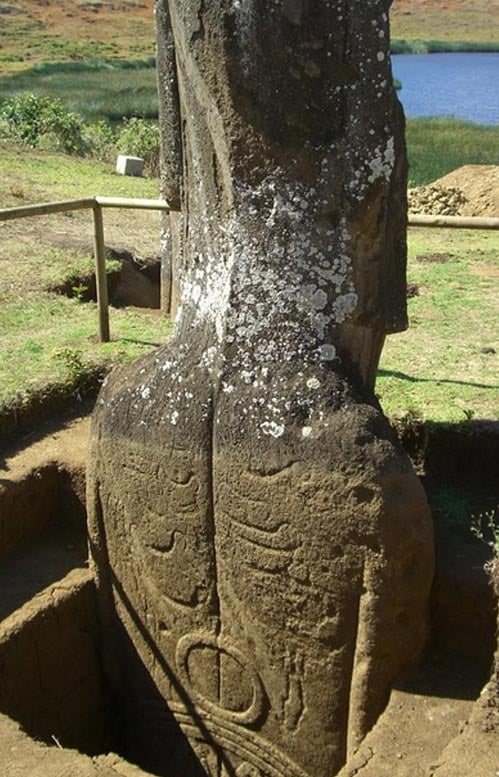easter island heads tattoo designs
Images from the 2012 excavation of Easter Island's iconic statues reveal the renowned heads are not only connected to giant bodies, but the bodies are covered in mysterious designs and symbols, which researchers have likened to tattoos.
With a study last week which claimed to have definitively worked out just how the Easter Islanders managed to lift the hats to the heads of the Moai statues, the next puzzle to solve is what exactly these body designs are all about.
News.com.au reported that a previously unseen series of photographs show in fascinating detail the excavated bodies of the distinctive stone humanoids. Archaeologists were surprised to find that the stone bodies, shielded from environmental weathering beneath the soil, are decorated with ancient details —whirls and crescents believed to be tattoos.
Researchers say the crescent shapes might represent the canoes of local Polynesians, though this is just one theory.

Detailed markings are visible. Credit: The Easter Island Statue Project
The Rapa Nui people who originally settled the island centuries ago erected 887 amazing giant stone statues called moai. The moai have proved to be an enduring mystery with many lasting questions; how and why were they built; were they purposefully buried or did time bury the statues under silt; why do some face away from the sea and towards the island; how were the heavy stones moved around the island; why do some sport heavy red stone hats ? Researchers hope to answer these questions and more with investigations.
- Demise of ancient Rapa Nui civilization linked to European contact
- The mysterious Rongorongo writing of Easter Island
- New Research Challenges Reason for Easter Island Collapse

Moais (stone statues) on Ahu Nau, Anakena Beach, Easter Island. Wikimedia Commons
Director of the Easter Island Statue Project, Jo Anne Van Tilburg says, "The reason people think they are [only] heads is there are about 150 statues buried up to the shoulders on the slope of a volcano, and these are the most famous, most beautiful and most photographed of all the Easter Island statues. This suggested to people who had not seen photos of [other unearthed statues] that they are heads only," reports news website IBTimes.
- The Statues and Symbolic Gestures that Link Ancient Göbekli Tepe, Easter Island, and Other Sites Around the World
- Study Claims to Have Solved Mystery of Giant Easter Island Hats
- The Cataclysm of Easter Island - Part 1
Initial excavations in 1914 revealed some of the bodies of the giant volcanic rock statues, which can weigh up to 88 tons and be up to 10 meters (33 feet) tall. The hands of some of the statues can be seen to wrap around to the navel .
Academics speculate the stylized figures represented ancestors or high status tribal figures. It is theorized that the stone was quarried on the island, and next it was carved and decorated at the quarries, and then finally the statues were "walked" slowly across the islands to their final positions as guardians protecting against disaster.
Explorer and author David Hatcher Childress wrote in a 2013 article:
Jean-Michel Schwartz says in his 1975 book 'The Mysteries of Easter Island' that he believes the statues were not moved by wooden rollers or sleds but rather by using ropes around the statues which 'walked' the statues in the same way as one might walk a refrigerator; by tilting it first to one side, shifting the airborne portion forward, and setting it down again. By this method, the statues would truly walk in a waddle fashion around the island.
Later, a Czech mechanical engineer named Pavel recreated this method along with Thor Heyerdahl. With twenty other men, they tied ropes around a statue and leaned it from side to side while pulling it forward with the rope, a slight variation on Schwartz's method. The method worked, but was excruciatingly slow. It is an ingenious theory which takes into account the legends of the walking statues […]
Easter Island was settled between 300 AD and 1200 AD by Polynesians who eventually became the Rapa Nui. Between the 10th and 16th centuries the island community expanded steadily, with settlements being set up along practically the entire coastline. Following this period, however, the population took an extremely rapid decline dropping from 15,000 to approximately 2,000. Past theories explained their demise as the result of economic and social crises due to environmental deterioration: deforestation leading to land erosion. However, recent studies suggest the arrival of Europeans in the 1700s, and slavery and smallpox , are factors which probably devastated the population of the Rapa Nui.
Work continues on the island through university-led research, and the Easter Island Statue Project , along with assistance from the Rapa Nui people.
Galleries of images of Easter Island discoveries can be seen at the EISP.org site, and others are currently being viewed on social media site Imgur .

The famous moai of Easter Island (BigStockPhoto)
To image: The intricately carved details as recorded in 2012. Archaeologists believe the decorations are tattoos. Credit: The Easter Island Statue Project
By Liz Leafloor
easter island heads tattoo designs
Source: https://www.ancient-origins.net/news-general/new-photos-reveal-giant-easter-island-moai-statues-are-covered-mysterious-symbols-020389
Posted by: dorseytecame.blogspot.com

0 Response to "easter island heads tattoo designs"
Post a Comment